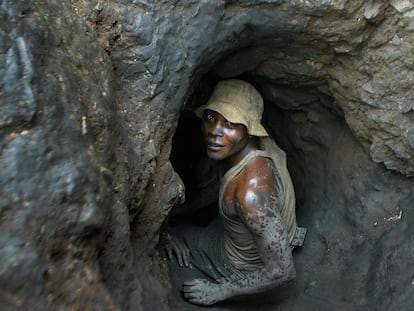Cactus or nothing: One million people in Madagascar live on the brink of starvation
The southern region of the ‘red island’ was thought to be the first country that would experience famine as a result of climate change, but experts warn that the cause of this crisis is structural poverty
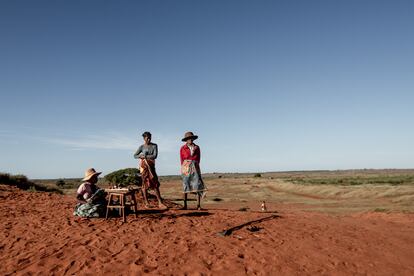
A land without roads in the southern region of an island in the middle of the Indian Ocean. A government slow to act. An international community that has spent 30 years financing ineffective development projects. Floods, droughts, sandstorms and cyclones. And now added to this series of misfortunes, over a million malnourished people, who almost exclusively subsist on cacti and wild fruits; during the worst moments, they have even ingested ash and dirty water. That’s the portrait of south Madagascar today.
The Republic of Madagascar, Africa’s great red island, gained international visibility in mid-2021. Humanitarian agencies and the government warned that insufficient rainfall since 2019 in the Grand Sud region led to the worst drought in 40 years. In some agricultural areas, 94% of the land was left barren, and the population succumbed to a food crisis that threatened their survival. Cyclones Batsirai and Freddy devastated villages and fields, and it was reported that this part of the world would experience the first famine caused by global warming. The United Nations and the government asked the international community for $76 million (€70 million) to mitigate the emergency.
Sabine Anette, a 23-year-old mother of a two-year-old son, lives in that remote southern region. She is one of the residents of Betoko, a village with just a handful of mud and thatch houses. The lack of rain has caused this woman and a dozen or so of her neighbors, all of whom have young children, to lose their crops. “We eat cactus and whatever we can find,” the young woman declares. For show, she disappears into the darkness of her hut and instantly emerges with a basket of prickly pears. That’s her entire food supply for her son, her 85-year-old grandmother and herself. At the height of the drought in 2021, three children died of starvation, her neighbors say.
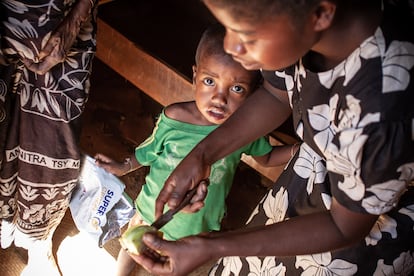
According to the UN Human Development Index, Madagascar is one of the poorest countries in the world; the international organization ranks it 173rd out of 191 states. At the same time, the country tops the list of countries most vulnerable to global warming. However, climate change was not the main driver of the current crisis, contrary to what was claimed at the time. Scientists from World Weather Attribution (WWA), an international coalition that studies the role of climate change in extreme events, analyzed the case of southern Madagascar. In the study Attribution of Severe Low Rainfall in Southern Madagascar, 2019-21, they pointed to the pre-existing fragility of the population as the cause of hunger. “Climate change is a threat multiplier, but [it’s] not the only one,” said Dr. Friederike Otto, the director of WWA.
The World Bank reports that over 80% of the population lives on less than $2 (€1.84) a day. Local communities struggle to cope with the prolonged period of drought. Without rain, there are no crops. Families then sell their zebu (a species of cattle) to buy food or migrate. Then they discard their pots and other personal belongings. The result is a collective decapitalization that deepens structural poverty. When the pandemic began, people were also unable to migrate in search of work.
After requesting anonymity, a group of three international diplomats based in the capital Antananarivo told EL PAÍS: “There are also droughts in other places, but not famine. It happens here because there’s nothing else. It is a structural poverty problem.”
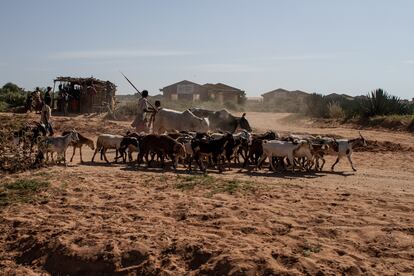
Madagascar’s government and different UN agencies have declared the situation a famine; that label is backed up by an analysis from the Famine Early Warning Systems Network (FEWSNET) and the Integrated Food Security Phase Classification (IPC). The latter includes five stages; famine is the last one. In late 2021, nearly 14,000 people were facing famine in the Anosy district. Now, because of the rainfall over the past few months, the region is moving between stages 2 and 3 in the food security classification system.
Another problem is the region’s distance from the capital: it is located over 1,000 kilometers away and to get there, one must travel on a single road with unpaved stretches. The journey by car takes at least 23 hours. Diplomats note that southern Madagascar’s population is made up of minority ethnic groups; they’ve been excluded from the political and economic elite, which consists primarily of the majority Merina ethnic group. “A historical problem persists between the north and the south. And since [southerners] are [a population of] two million people [out of a total of more than 28 million inhabitants], they are of no electoral interest,” a diplomat says.

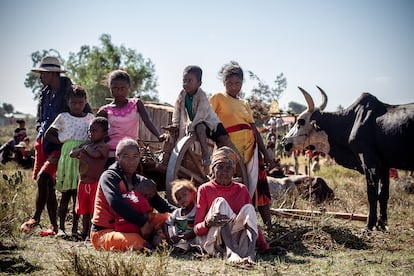
The precariousness of the Malagasy south is obvious, even without reading scholarly reports. In the districts of Androy and Anosy, the areas most affected by this crisis, there are hardly any paved roads. When it rains, these roads are impassable, and the villages are isolated. The landscape has dry tributaries of the Mandrare River, the largest in the region, and rows of cactus and sisal plantations, almost 7,000 hectares that a French company has owned since before the country gained independence in 1960.
Nandrasa Longomaro, 21, works on one of these plantations. On a good day, she earns 1,000 ariari, about 20-euro cents, but rarely more than 400 ariari, she says at the Amabanisarika health center. She is there because her two-year-old daughter Sambelahy suffers from severe malnutrition, like 450,000 children in this region, according to UNICEF. The little girl is undergoing treatment and has gained one kilo (about 2.2 pounds); she now weighs seven kilos (about 15.4 pounds). “What I earn is not enough to feed us; it only gives me enough to buy some corn or some rice.” In her household—which also includes her mother and siblings, nine people— they frequently go to bed on an empty stomach.
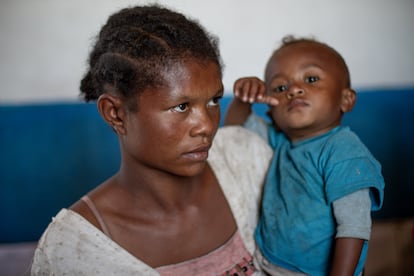
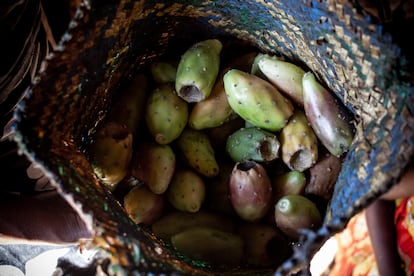
On April 22, President Andry Rajoelina posted photos of his visit to the construction site of the 97-kilometer Efaho aqueduct, which will benefit half a million Androy inhabitants, on Instagram. For at least two decades, such infrastructures have been developed in southern Madagascar. In the town of Amboasary, a gleaming new water tank is still not functioning. In Betoko, the water pump from another development project is broken. Local women drink unsafe water from the river, running the risk of contracting parasitic diseases and diarrhea.
A development project “graveyard”
An EU-funded study, to which EL PAÍS had access, analyzes the last 30 years of development projects in Madagascar to find out why the country is still so dependent on emergency aid. “Numerous programs have been operating there for decades, attempting to respond to the population’s most immediate needs (...) Few initiatives have been able to drive the development dynamics that would bring about enduring change, making the Grand Sud region a graveyard of [development] projects,” the document argues. One diplomat shows photographs of milling machines sealed in a warehouse. “[The machines] were covered in plastic for eight years because no one had explained to the women what to do with them,” he laments.
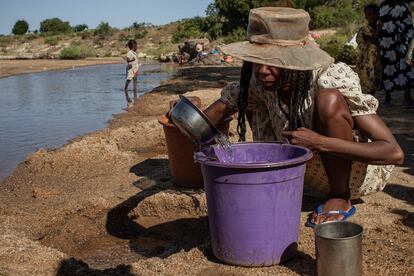
The European Union’s Directorate-General for European Civil Protection and Humanitarian Aid Operations (ECHO)—which invited this newspaper on the trip to Madagascar on which this article is based—has invested €47 million ($51,189,580) in humanitarian aid for the country between 2021 and 2023. One of the projects it supports is the Agroecological Technical Center of the South. Its director, Stéphanie Andoniaina, describes a very conservative society; she emphasizes the importance of adapting to the cultural and anthropological context. “Peas would grow here, but they are forbidden because of superstitions. The solution we found was to introduce a variety into the communities that they were okay with.”
A month ago, long-awaited rain finally came to southern Madagascar. A grateful land became greener. On some roads, puddles remain. Cassava, maize, sweet potato and peanuts returned to local markets and pantries. But now farmers are looking at the sky with concern: if it doesn’t rain in October, they will once again experience problems. CPI projections estimate that, between May and August 2023, one million people—a third of the southern population—are on the brink of a food emergency. Most of the Mandrare riverbed remains so dry that trucks and zebus can pass over where the river should flow.
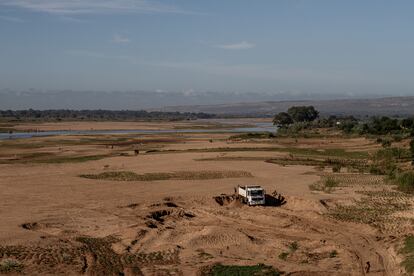
Sign up for our weekly newsletter to get more English-language news coverage from EL PAÍS USA Edition
Tu suscripción se está usando en otro dispositivo
¿Quieres añadir otro usuario a tu suscripción?
Si continúas leyendo en este dispositivo, no se podrá leer en el otro.
FlechaTu suscripción se está usando en otro dispositivo y solo puedes acceder a EL PAÍS desde un dispositivo a la vez.
Si quieres compartir tu cuenta, cambia tu suscripción a la modalidad Premium, así podrás añadir otro usuario. Cada uno accederá con su propia cuenta de email, lo que os permitirá personalizar vuestra experiencia en EL PAÍS.
¿Tienes una suscripción de empresa? Accede aquí para contratar más cuentas.
En el caso de no saber quién está usando tu cuenta, te recomendamos cambiar tu contraseña aquí.
Si decides continuar compartiendo tu cuenta, este mensaje se mostrará en tu dispositivo y en el de la otra persona que está usando tu cuenta de forma indefinida, afectando a tu experiencia de lectura. Puedes consultar aquí los términos y condiciones de la suscripción digital.
More information
Archived In
Últimas noticias
Most viewed
- Sinaloa Cartel war is taking its toll on Los Chapitos
- Reinhard Genzel, Nobel laureate in physics: ‘One-minute videos will never give you the truth’
- Oona Chaplin: ‘I told James Cameron that I was living in a treehouse and starting a permaculture project with a friend’
- Why the price of coffee has skyrocketed: from Brazilian plantations to specialty coffee houses
- David King, chemist: ‘There are scientists studying how to cool the planet; nobody should stop these experiments from happening’

